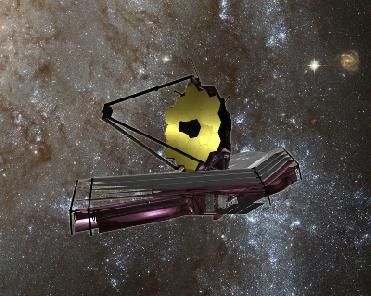
An artist's conception of JWST in space. NASA photo
WASHINGTON (BNS): The James Webb Space Telescope that will take the place of Hubble telescope is getting ready for its space launch scheduled for 2013. It is crisscrossing seven different states in the US for its space mission.
Jeff Kegley of NASA's Marshall Space Flight Center said to find the first stars and galaxies that were formed in the early universe which are millions and even billions of light years away, the Webb telescope mirror has to be �wickedly smooth�.
Every precaution is being taken while transporting the 18 mirror segments that will form the Webb telescope's huge primary mirror. When questioned about how many years one will have to wait if one of the mirrors was broken, Helen Cole, also of Marshall, said it was something one didn't want to talk about.
If one traces the Webb telescope's mirror segment's Earthly journey from rough start to �wickedly smooth� and finally to union with its 17 siblings to form a 6.5 meter (21 � foot) wide whole with a total area of 25 square-meters (almost 30 square yards), the story begins in a Utah beryllium mine. Beryllium is one of the lightest of all metals, and the �stuff� of the telescope's mirrors.
Explaining the journey, NASA said technicians in Ohio sift and purify the gritty beryllium powder from Utah into an extremely uniform optical grade especially for the Webb mirror. Then they pour the powder in a big, flat can, apply heat and pressure, and pump out the residual gas to create a large slab called a mirror billet. They bathe the billet in acid to burn off any stainless steel stuck to the billet when the can is removed. Next they split the billet in half Oreo-cookie-style to form two mirror blanks. These mirror blanks are the largest ever produced in beryllium.
Then workers in Alabama machine the back of each blank into a honeycomb structure to make the blanks lighter without reducing stiffness. The machined ribs are less than 1 millimeter thick -- almost paper cut thin, the space agency said.
Lee Feinberg of the Goddard Space Flight Center said that this precision machining and etching removes 92 percent of a blank's mass. "Mass is critical in launching space missions," he said.
Next, a California company grinds and polishes the segments to a very smooth and exact shape and optically tests them at a room temperature. "But the Webb telescope will not operate in room temperature. Not only will this telescope mirror be 'wickedly smooth', it will also be wickedly cold in space. Because it is an infrared telescope, the JWST is designed to pick up the heat of faint, awesomely distant stars and galaxies. To do that it has to be kept extremely cold. It will operate in space at about -238 deg Celsius (-396 deg Fahrenheit, 35K)," NASA said.
"The extreme cold may cause the telescope's structures and mirrors to change shape, so testing has to be done here on Earth under similar, hyper-cold conditions," Cole said.
This super-cold testing is done in Alabama. The Marshall Space Flight Center's X-ray & Cryogenic Facility has a vacuum chamber that can simulate the incredibly cold conditions of space. Testing in this chamber reveals even the tiniest distortions that happen to the mirror segments in the cold. The tests provide precise data that specifies the exact re-polishing to be done to compensate ahead of time for distortions likely to occur in space. Once the mirror segments are polished to precision, gold is evaporated over them, forming a very thin coating on the smooth mirror surface, the space agency said.
"This gold coating is highly reflective over all the wavelengths of the Webb telescope, from visible to mid-infrared," Feinberg said.
All 18 segments finally arrive at Goddard Space Flight Center. "Here, they're mounted on structures that will ultimately hold them in place and let them perform as if they were part of a single giant hexagonal mirror. (The mirror structure will be folded with its shield origami style when it's time to fit in a rocket.) Next the telescope is fully assembled and attached to the instrument module and the whole kit and caboodle is acoustic and vibration tested," NASA said.
The final cryogenic testing takes place at Johnson Space Center, in the same vacuum chamber that tested the Apollo Lunar Lander.
The telescope is then integrated with the spacecraft and sunshield at Northrop Grumman in California. It will lift-off from Kourou, French Guiana, on an Ariane 5 rocket in 2013.
 Previous Article
Previous Article Next Article
Next Article












The Indian Air Force, in its flight trials evaluation report submitted before the Defence Ministry l..
view articleAn insight into the Medium Multi-Role Combat Aircraft competition...
view articleSky enthusiasts can now spot the International Space Station (ISS) commanded by Indian-American astr..
view article